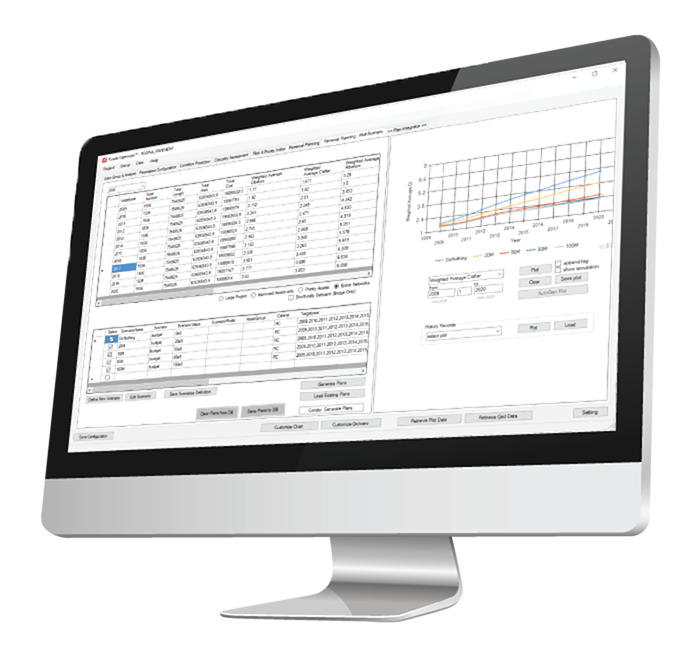Roads Optimizer™ implements a set of revolutionary algorithms to support optimal multi-year preservation planning of road networks. The algorithms include inductive multi-variate deterioration modeling, quantitative risk assessment and asset prioritization, and multi-objective optimization. Roads Optimizer™ offers a rich set of features unparalleled by any other software in the market today.

Optimized Preservation Plans & Trade-off Analysis
Roads Optimizer™ allows users to investigate a range of planning scenarios, including: (1) scenarios to evaluate the impact of funding levels on network-level condition and risk measures; and (2) scenarios to evaluate funding requirements to achieve desired condition/risk objectives. Asset managers can define scenario parameters such as planning horizon, budget profile, varying annual levels of condition/risk levels, budget splitting among treatments, and annual inflation rates. For each scenario, Roads Optimizer™ generates optimal and feasible project lists, on annual basis. Selected projects satisfy all defined constraints and are guaranteed to be optimal. Trade-off analysis functions will provide asset managers with rich analytics tools (e.g., queries, charting functions, etc.) to quantitatively assess the consequences of various policies and scenarios on the condition and risk levels of individual road sections, groups of sections, or on the entire network. This analysis will help asset managers make rational and evidence-based decisions to determine the most cost-effective long-term preservation plan


Reliable Prediction of Pavement Deterioration
Roads Optimizer™ implements a revolutionary multi-variate inductive algorithm to accurately predict pavement deterioration. Unlike other empirical and mechanistic-empirical models which assume that the deterioration process follows a “predefined” known distribution function, our algorithm does not assume any “prior” knowledge of the deterioration function. Instead, it analyzes historical inspection data and correlates independent variables (e.g., age, traffic volume, road width, design loads) with (IRI, rut, cracking) and condition grades to automatically “infer” (or “learn”) the distribution function that most closely captures the relationship between these variables and pavement deterioration. Furthermore, our algorithm is tolerable to data impreciseness and uncertainties typically experienced in inspections and condition rating data.


Customizable Treatment Methods Database
Roads Optimizer™ a built-in database of pavement treatments and rehabilitation methods, including seal coating, micro-surfacing, overlays, and reconstruction. The database also includes a set of customizable constraints and formulae for calculating costs and benefits, as well as to determine applicability constraints of each treatment. Applicability constraints are defined to limit the use of treatment methods to ensure technical and economic feasibility in any given circumstances. Users can customize the formulae for estimating lifecycle costs and expected impact of various treatments, to reflect agency-specific constraints and preferred practices.


Risk-Based Prioritization
Roads Optimizer™ implements a risk-based prioritization algorithm that considers road condition state (or likelihood of failure) along with the “relative” consequence of failure (or criticality). Criticality of a pavement segment is determined by evaluating a number of static or time-dependent factors such as functional class, traffic volume, weight regime, etc. For each pavement section, a “risk index” is calculated as the product of the consequence of failure and the likelihood of failure. Risk levels are then used to establish a priority scale to rank segments based on the urgency of pavement treatments.


Advanced Data Analytics
Roads Optimizer™ maintains a centralized enterprise database to integrate roads inventory and geometric data, geospatial data, traffic data, inspection and condition data, risk-related data, and rehabilitation methods data. Data on preservation planning scenarios and results are also maintained in the database. The database can be efficiently queried using a user-friendly Query Builder. Asset managers can use the charting functions (boxplots, scatter plots, histograms, and pie charts) to efficiently investigate data trends and relationships. Queries and charts can be created for individual bridges, group of bridges, or the entire inventory. Historical data trends can be identified using linear, polynomial, or exponential curve fitting functions.


Customizable
Roads Optimizer™ can be easily customized to reflect agency-specific data, preservation policies, planning constraints and scenarios, and various forms of presentations and reporting. It can seamlessly integrate and share data with other software, including most commonly used GIS (ArcGIS or Geomedia) and pavement management systems.





